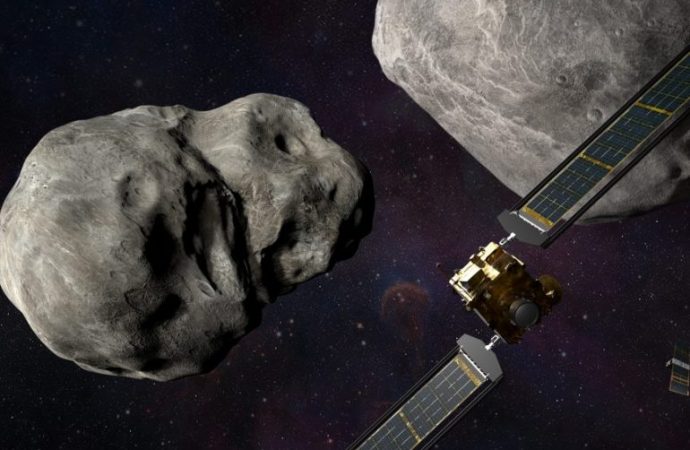DART probe, the size of a car, will slam into the Dimorphos ‘moonlet’ at more than 24,000 kilometres per an hour in an attempt to knock it off course.
Source: Aljazeera.com
NASA launched a mission to deliberately smash a spacecraft into an asteroid – a test-run should humanity ever need to stop a giant space rock from wiping out life on Earth.
It may sound like science fiction, but the DART – Double Asteroid Redirection Test – is a real proof-of-concept experiment. It blasted off at 10:21pm on Tuesday (06:21 GMT Wednesday) on board a SpaceX rocket from Vandenberg Space Force Base in California.
The goal is to slightly alter the trajectory of Dimorphos, a “moonlet” about 160 metres (525 feet) wide that circles a much larger asteroid called Didymos 762 metres (2,500 feet) in diameter. The pair orbit the Sun together.
Impact should take place in the third quarter of 2022 when the binary asteroid system is 11 million kilometres (6.8 million miles) from Earth, almost the nearest point they ever get.
“What we’re trying to learn is how to deflect a threat,” NASA’s top scientist Thomas Zuburchen said of the $330m project, the first of its kind.
To be clear, the asteroids in question pose no threat to the planet. But they belong to a class of bodies known as Near-Earth Objects (NEOs), which approach within 48 million kilometres (30 million miles).
NASA’s Planetary Defense Coordination Office is most interested in those larger than 140 metres (460 feet) in size, which have the potential to level entire cities or regions with many times the energy of the average nuclear bomb.
There are 10,000 known near-Earth asteroids that size or greater, but none has a significant chance of hitting in the next 100 years. One big caveat: scientists think there are still 15,000 more such objects waiting to be discovered.
Planetary scientist Essam Heggy said while the NASA mission sounds like science fiction, the threat to the planet is real if the fate of the dinosaurs 80 million years ago is recalled.
“The chances of getting hit again by an asteroid is far from science fiction,” he told Al Jazeera. “Asteroids 100 metres and greater are a threat to the Earth, and we need to quantify our deflection capability to these threats.”
24,000kph kick
Planetary scientists can create miniature impacts in labs and use the results to create sophisticated models about how to divert an asteroid – but models are always inferior to real-world tests.
Scientists say the Didymos-Dimorphos system is an “ideal natural laboratory” because Earth-based telescopes can easily measure the brightness variation of the pair and judge the time it takes the moonlet to orbit its big brother.
Since the current orbit period is known, the change will reveal the effect of the collision, scheduled to occur between September 26 and October 1, 2022.
What is more, since the asteroids’ orbit never intersects Earth, they are thought safer to study.
The DART probe, which is a box the size of a large fridge with limousine-sized solar panels on either side, will slam into Dimorphos at more than 24,000 kilometres per hour (15,000 miles per hour).
Andy Rivkin, the DART investigation team lead, said the current orbital period is 11 hours and 55 minutes, and the team expects the kick will shave 10 minutes off that time.
There is some uncertainty about how much energy will be transferred by the impact because the moonlet’s internal composition and porosity are not known.
The more debris that is generated, the more push will be imparted on Dimorphos.
“Every time we show up at an asteroid, we find stuff we don’t expect,” said Rivkin.
The DART spacecraft also contains sophisticated instruments for navigation and imaging, including the Italian Space Agency’s Light Italian CubeSat for Imaging of Asteroids (LICIACube) to watch the crash and its after-effects.
“The CubeSat is going to give us, we hope, the shot – the most spectacular image of DART’s impact and the ejecta plume coming off the asteroid. That will be a truly historic, spectacular image,” said Tom Statler, DART’s programme scientist.
Armageddon scenario
The so-called “kinetic impactor” method is not the only way to divert an asteroid, but it is the only technique ready to deploy with current technology.
Others that have been hypothesised include flying a spacecraft close by to impart a small gravitational force.
Another is detonating a nuclear blast close by – but not on the object itself, as in the films Armageddon and Deep Impact – which would probably create many more perilous objects.
Scientists estimate 140-metre asteroids strike once every 20,000 years.
Asteroids that are 10km (6 miles) or wider – such as the one that struck 66 million years ago and led to the extinction of most life on Earth, including the dinosaurs – occur every 100-200 million years.
DART is the latest of several NASA missions of recent years to explore and interact with asteroids, primordial rocky remnants from the solar system’s formation 4.6 billion years ago.
Last month, NASA launched a probe on a voyage to the Trojan asteroid clusters orbiting near Jupiter, while the grab-and-go spacecraft OSIRES-REx is on its way back to Earth with a sample collected last October from the asteroid Bennu.

Source: Aljazeera.com

































Leave a Comment
You must be logged in to post a comment.